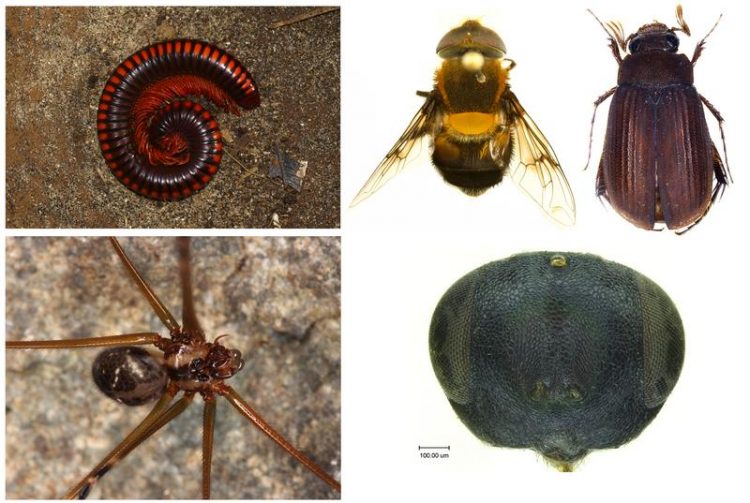1000 new species discovered and described

Examples of the newly discovered species copyright: ZFMK, Bonn
While public interest on possible extrateestrial life is increasing, only a fraction of the biodiversity of our own planet is known. Current estimates suggest that there may be over eight million living species worldwide, but less than two million have been scientifically described.
Six scientists from the Arthropoda Department of the Museum Koenig in Bonn (Zoological Research Museum Alexander Koenig – Leibniz-Institute for Animal Biodiversity) have been doing their share in filling this gap and have described over 1,000 new species during the last ten years.
Their new species come from all over the world and include mainly beetles, spiders, millipedes, flies, and butterflies. Many specimens have been collected during recent expeditions by the scientists themselves, whilst others come from the museum in Bonn and from other institutions. In these “treasure chests”, many species wait for decades until they are scientifically described.
To recognize a species as new to science and to scientifically describe it often take a long time and both processes may be compared with the meticulous search of a criminologist. It has to be ascertained that a potentially new species is truly different from all previously described species. In case of doubt, it is only by comparison with the specimens originally used to describe similar species – the so-called type specimens – that it can be decided whether the species in question is already known or indeed new.
For this reason, museums such as Museum Koenig play an important role as archives of biodiversity in space and time. As a result of the environmental degradation, species are currently disappearing more rapidly than during the last millions of years.
Taxonomists, the scientists that are occupied with discovering biodiversity, are thus engaged in a kind of race against time to describe as many species as possible before part of this diversity is forever gone.
At the same time, it is not only the species but also the taxonomists who are disappearing. For many animal groups there is an increasing lack of specialists capable to provide the fundaments for biology and related disciplines.
Nature protection and environmental conservation depend on taxonomy as do agronomy, parts of medicine, and evolutionary research. The neglect of taxonomic training at universities, the scarcity of job positions, and the often inadequate financial support are just three of the many reasons for the shortage of taxonomists.
Together with colleagues all over the world, the taxonomists in Bonn strive to counteract this development. Traditional approaches and methodologies to study unknown species are increasingly combined with modern technologies. Morphological and molecular data are gathered in integrative approaches, using both to characterize species. For example, genetic fingerprints, also known as DNA barcodes, are used in an effort to speed up the process of species identification. The next 1000 species will hopefully not take another decade.
Contact:
Dr. Dirk Ahrens, Dr. Bernhard Huber, Dr. Ximo Mengual-Sanchis, Dr. Ralph Peters, Dr. Dieter Stüning, Dr. Thomas Wesener
Zoological Research Museum Alexander Koenig – Leibniz-Institute for Animal Biodiversity
Adenauerallee 160, 53113 Bonn, Germany
Tel.: +49 (0)228 9122 0
Fax: +49 (0)228 9122 212
www.zfmk.de
E-Mail:
d.ahrens@zfmk.de
b.huber@zfmk.de
x.mengual@zfmk.de
r.peters@zfmk.de
t.wesener@zfmk.de
Illustration: Examples of the newly discovered species: (from top left to bottom right): the millipede Aphistogoniulus infernalis Wesener, 2009; the hoverfly Palpada prietorum Mengual, 2008; the may beetle Neoserica sapaensis Ahrens, Liu & Fabrizi, 2014; the daddy-long-legs spider Aetana omayan Huber, 2005; and the chalcid wasp Dibrachys verovesparum Peters & Baur, 2011 (detail image of the head).
Zoological Research Museum Alexander Koenig – Leibniz-Institute for Animal Biodiversity (ZFMK) is an independent research institute. The focus of research is on performing an inventory of the zoological species diversity on earth, on the analysis of changes in biodiversity as a result of environmental factors, and on evolutionary processes at the morphological and molecular levels. ZFMK furthermore explores the context of structure and function of ecological systems, advanced scientific methods, and the study of the history of science. The permanent exhibition “Our blue planet – the living network” offers a genuine nature experience based on naturalistic ecosystem displays.
The Leibniz Association is a network of 89 scientifically, legally, and economically independent research institutes and scientific service facilities. Leibniz Institutes perform strategic and thematically-oriented research and offer scientific service of national significance while striving to find scientific solutions for major social challenges.
Media Contact
All latest news from the category: Life Sciences and Chemistry
Articles and reports from the Life Sciences and chemistry area deal with applied and basic research into modern biology, chemistry and human medicine.
Valuable information can be found on a range of life sciences fields including bacteriology, biochemistry, bionics, bioinformatics, biophysics, biotechnology, genetics, geobotany, human biology, marine biology, microbiology, molecular biology, cellular biology, zoology, bioinorganic chemistry, microchemistry and environmental chemistry.
Newest articles

High-energy-density aqueous battery based on halogen multi-electron transfer
Traditional non-aqueous lithium-ion batteries have a high energy density, but their safety is compromised due to the flammable organic electrolytes they utilize. Aqueous batteries use water as the solvent for…

First-ever combined heart pump and pig kidney transplant
…gives new hope to patient with terminal illness. Surgeons at NYU Langone Health performed the first-ever combined mechanical heart pump and gene-edited pig kidney transplant surgery in a 54-year-old woman…

Biophysics: Testing how well biomarkers work
LMU researchers have developed a method to determine how reliably target proteins can be labeled using super-resolution fluorescence microscopy. Modern microscopy techniques make it possible to examine the inner workings…





















